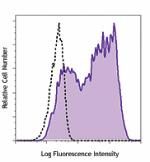- Clone
- 14E3G7 (See other available formats)
- Regulatory Status
- RUO
- Other Names
- For CD209: CDSIGN, CLEC4L, DC-SIGN, DC-SIGN1, For CD299: LSIGN, CD209L, L-SIGN, DCSIGNR, HP10347, DC-SIGN2, DC-SIGNR
- Isotype
- Mouse IgG2b, κ
- Barcode Sequence
- AGAACAGTCAGTCGC
| Cat # | Size | Price | Quantity Check Availability | ||
|---|---|---|---|---|---|
| 845003 | 10 µg | $369.00 | |||
DC-SIGN is a C-type lectin that has a high affinity for the ICAM3 molecule. It binds various microorganisms by recognizing high-mannose-containing glycoproteins on their envelopes. It especially functions as a receptor for several viruses such as HIV and Hepatitis C. L-SIGN is a transmembrane receptor and is referred to as L-SIGN because of its expression in the endothelial cells of the lymph nodes and liver. The protein is involved in the innate immune system and recognizes numerous evolutionarily divergent pathogens ranging from parasites to viruses. The protein is organized into three distinct domains: an N-terminal transmembrane domain, a tandem-repeat neck domain, and a C-type lectin carbohydrate recognition domain.
Product Details
- Verified Reactivity
- Human
- Antibody Type
- Monoclonal
- Host Species
- Mouse
- Immunogen
- DC-SIGN DNA.
- Formulation
- Phosphate-buffered solution, pH 7.2, containing 0.09% sodium azide and EDTA
- Preparation
- The antibody was purified by chromatography and conjugated with TotalSeq™-C oligomer under optimal conditions.
- Concentration
- 0.5 mg/mL
- Storage & Handling
- The antibody solution should be stored undiluted between 2°C and 8°C. Do not freeze.
- Application
-
PG - Quality tested
- Recommended Usage
-
Each lot of this antibody is quality control tested by immunofluorescent staining with flow cytometric analysis and the oligomer sequence is confirmed by sequencing. TotalSeq™-C antibodies are compatible with 10x Genomics Chromium Single Cell Immune Profiling Solution.
To maximize performance, it is strongly recommended that the reagent be titrated for each application, and that you centrifuge the antibody dilution before adding to the cells at 14,000xg at 2 - 8°C for 10 minutes. Carefully pipette out the liquid avoiding the bottom of the tube and add to the cell suspension. For Proteogenomics analysis, the suggested starting amount of this reagent for titration is ≤ 1.0 µg per million cells in 100 µL volume. Refer to the corresponding TotalSeq™ protocol for specific staining instructions.
Buyer is solely responsible for determining whether Buyer has all intellectual property rights that are necessary for Buyer's intended uses of the BioLegend TotalSeq™ products. For example, for any technology platform Buyer uses with TotalSeq™, it is Buyer's sole responsibility to determine whether it has all necessary third party intellectual property rights to use that platform and TotalSeq™ with that platform. - Application Notes
-
Clone 14E3G7 has been shown to recognize both CD209 and CD299 transfectants.1
- Additional Product Notes
-
TotalSeq™ reagents are designed to profile protein levels at a single cell level following an optimized protocol similar to the CITE-seq workflow. A compatible single cell device (e.g. 10x Genomics Chromium System and Reagents) and sequencer (e.g. Illumina analyzers) are required. Please contact technical support for more information, or visit biolegend.com/totalseq.
The barcode flanking sequences are CGGAGATGTGTATAAGAGACAGNNNNNNNNNN (PCR handle), and NNNNNNNNNCCCATATAAGA*A*A (capture sequence). N represents either randomly selected A, C, G, or T, and * indicates a phosphorothioated bond, to prevent nuclease degradation.
View more applications data for this product in our Scientific Poster Library. -
Application References
(PubMed link indicates BioLegend citation) -
- Granelli-Piperno A, et al. 2005. J. Immunol. 175:4265.
- RRID
-
AB_2890854 (BioLegend Cat. No. 845003)
Antigen Details
- Structure
- DC-SIGN is a 44 kD type II transmembrane glycoprotein and a member of the C-type lectin family. DC-SIGNR (DC-SIGN-related molecule) is a type II integral membrane protein that is 77% identical to DC-SIGN.
- Distribution
-
CD209 is expressed on myeloid dendritic cells, placental macrophages, and liver and placental endothelial cells. CD299 is expressed on liver sinusoidal endothelial cells, lung and placental endothelial cells, type 2 alveolar cells, and endothelial cells of lymph nodes.
- Function
- CD299 mediates interactions between dendritic cells and resting T cells and has a high affinity for HIV-1 gp120. CD209 plays a critical role in capturing and internalizing pathogens. LSP1 (leukocyte-specific protein 1) interacts with the cytoplasmic domain of CD209 and mediates the transport of HIV to the proteasome.
- Interaction
- CD209 is a receptor of viruses such as HIV-1, West Nile Virus, hepatitis C virus, some bacteria, and parasites. CD299 binds carbohydrate structures of pathogens such as hepatitis C virus, Mycobacterium, etc.
- Ligand/Receptor
- CD209 binds to ICAM-3 (CD50), ICAM-2 (CD102), and Butyrophilin (BTNA2A1). CD299 is a receptor for ICAM-3 (CD50).
- Cell Type
- Dendritic cells, Endothelial cells, Macrophages
- Biology Area
- Cell Biology, Immunology, Innate Immunity, Neuroinflammation, Neuroscience
- Molecular Family
- CD Molecules
- Antigen References
-
1. Fauci A. 1996. Nature 384:529.
2. Yokoyama-Kobayashi M, et al. 1999. Gene 228:161.
3. Soilleux EJ, et al. 2000. J. Immunol. 165:2937.
4. Pohlmann S, et al. 2001. Proc. Natl. Acad. Sci. USA 98:2670.
5. Bashirova AA, et al. 2001. J. Exp. Med. 193:671.
6. Lai WK, et al. 2006. Am. J. Pathol. 169:200. - Gene ID
- 30835 View all products for this Gene ID 10332 View all products for this Gene ID
- UniProt
- View information about CD209 on UniProt.org
Other Formats
View All CD209 Reagents Request Custom Conjugation| Description | Clone | Applications |
|---|---|---|
| Purified anti-CD209/CD299 (DC-SIGN/L-SIGN) | 14E3G7 | FC |
| TotalSeq™-C1138 anti-CD209/CD299 (DC-SIGN/L-SIGN) Antibody | 14E3G7 | PG |
Compare Data Across All Formats
This data display is provided for general comparisons between formats.
Your actual data may vary due to variations in samples, target cells, instruments and their settings, staining conditions, and other factors.
If you need assistance with selecting the best format contact our expert technical support team.
-
Purified anti-CD209/CD299 (DC-SIGN/L-SIGN)

Human monocyte-derived dendritic cells were stained with pur... -
TotalSeq™-C1138 anti-CD209/CD299 (DC-SIGN/L-SIGN) Antibody
